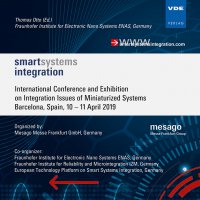Atom Chip technology for use under UHV conditions
Konferenz: Smart Systems Integration - 13th International Conference & Exhibition on Integration Issues of Miniaturized Systems
10.04.2019 - 11.04.2019 in Barcelona, Spain
Tagungsband: Smart Systems Integration
Seiten: 7Sprache: EnglischTyp: PDF
Persönliche VDE-Mitglieder erhalten auf diesen Artikel 10% Rabatt
Autoren:
Kassner, Alexander; Rechel, Mathias; Wurz, Marc C. (Institute of Micro Production Technology (IMPT), An der Universität 2, 30823 Garbsen, Germany)
Heine, Hendrik; Herr, Waldemar; Rasel, Ernst M. (Institute of Quantum Optics (IQO), Welfengarten 1, 30167 Hannover, Germany)
Christ, Marc; Krutzik, Markus (Joint Lab Integrated Quantum Sensors, Ferdinand-Braun-Institut, Leibniz-Institut für Höchstfrequenztechnik, Gustav-Kirchhoff-Straße 4, 12489 Berlin, Germany)
Inhalt:
In matter wave interferometry, the wave properties of atoms are used for the precise measurement of inertial forces by investigating the frictionless free fall of atoms in a vacuum. Analogous to the Mach-Zehnder interferometer with its mirrors and beam splitters, the matter wave interferometer uses light pulses to manipulate the atoms. In this case, Bose-Einstein condensates (BEC) serve as a source for matter wave interferometry to further improve drift and accuracy performance compared to atom interferometers. To generate a BEC, an ensemble of atoms (here: Rb) is trapped in a magneto-optical trap (MOT) and cooled by laser cooling. It is utilised that the momentum of an atom changes through the absorption and (spontaneous) emission of a photon, because temperature is defined by distribution function of all kinetic energies of all atoms involved. If this function is very broad, the ensemble is hot, if this distribution function is narrow, the ensemble is cold. The atom cloud is compressed by the reduction of the magnetic field gradient, then the MOT is switched off and an optical molasses is applied for a few milliseconds to further reduce the temperature. This is followed by a 100 mus laser pulse for optical state preparation. The planar tracks of the atom chip are energized and the atoms are trapped in the pure magnetic field by the Zeeman effect. The temperature of the atom cloud is cooled down to the critical temperature for Bose-Einstein condensation by radiofrequency evaporative cooling. The sensitivity of the measurement increases squarely with the free fall time of the BEC. A longer free fall of atoms in the interferometer increases the sensitivity, therefore experiments were performed in microgravity environment. The miniaturization and further development of atom chips as a source of Bose-Einstein condensates (BECs) in transportable quantum gravimeters for the use in the field or on board sounding rockets, as demonstrated in, represents a manufacturing challenge with regard to the integration of the chips and their reliability. Since the operation takes place under ultra-high vacuum conditions, the use of non-adhesive connection techniques is given the highest priority. In addition, optical access to the chip surface is required for laser interferometry and laser cooling in order to realize a magneto-optical trap. In order to reduce the number of laser beams required, optical gratings are used on the chip surface to enable single beam operation. These require planar surfaces. In the following, the manufacture of the atom chip on a micro technological basis and the joining of the chip to a carrier system using transient liquid phase bonding are described. Furthermore, first approaches for backside contacting of the chip by vertical interconnect access are investigated.


